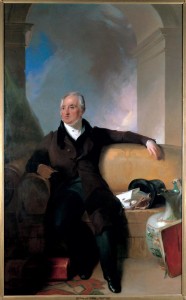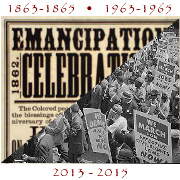A school built by abolitionists — and a slave trader
Posted January 20th, 2014 by James DeWolf PerryCategory: History, Outreach Tags: Martin Luther King Jr., Perkins School for the Blind, Slave trade, Thomas Handasyd Perkins
 This year, to commemorate the life of Dr. Martin Luther King, Jr., I was invited to speak at Perkins School for the Blind and to participate in the school’s Martin Luther King, Jr. Day activities. Perkins School was founded 185 years ago as the first school for the blind in the United States, and has spent that time as a leader in innovating technology and pedagogy for educating the blind, the deafblind, and those with additional disabilities.
This year, to commemorate the life of Dr. Martin Luther King, Jr., I was invited to speak at Perkins School for the Blind and to participate in the school’s Martin Luther King, Jr. Day activities. Perkins School was founded 185 years ago as the first school for the blind in the United States, and has spent that time as a leader in innovating technology and pedagogy for educating the blind, the deafblind, and those with additional disabilities.
The students of Perkins celebrated King’s life through music and with a dramatic reading of his famous “I Have a Dream” speech. As the keynote speaker, I focused on telling the story of my family, the DeWolf slave-trading family, as we uncovered our family’s hidden past and worked to turn that history into a documentary film, Traces of the Trade. I talked about how our family’s history illustrates the much broader involvement of New England, the North, and the entire United States in slavery and the slave trade. I spoke of the ways in which so many of us in this country are tied to the history of slavery, and benefit from that history today, and about the importance of acknowledging this history, rather than finding a way to turn away from the truth or to insist that this history is really about other people, and not about ourselves.
The students were also provided a dramatic illustration of how to acknowledge this history by the school’s president, Steven M. Rothstein, through an op-ed he wrote for this occasion, which ran last week in the Boston Globe under the headline, “A school built by abolitionists — and a slaver.” In this essay, Mr. Rothstein detailed how the history of Perkins includes strong ties to progressive abolitionists—but that the school is also named for a wealthy benefactor, Thomas Handasyd Perkins, who made part of his fortune in the slave trade.
Mr. Rothstein is entirely candid as he describes the lasting significance of Perkin’s slave-trading for the school’s history and for its welfare today:
Simply put, the wealth that Perkins acquired in part from the slave trade over 200 years ago helped to lay the financial foundation for our school.
 Perkins was, as Mr. Rothstein noted, not just a merchant who traded in slaves, but also a “major industrial investor” whose holdings included significant investments in the textile industry—the profits from which were also dependent on southern, slave-produced cotton. And as Pleun Bouricius of Mass Humanities noted earlier today, Perkins was also active in what was euphemistically called the “China trade,” that is, he was a major figure in the illegal opium trade, which would make him something akin to a drug lord today.
Perkins was, as Mr. Rothstein noted, not just a merchant who traded in slaves, but also a “major industrial investor” whose holdings included significant investments in the textile industry—the profits from which were also dependent on southern, slave-produced cotton. And as Pleun Bouricius of Mass Humanities noted earlier today, Perkins was also active in what was euphemistically called the “China trade,” that is, he was a major figure in the illegal opium trade, which would make him something akin to a drug lord today.
I don’t have to explain to readers of this blog why it is so important that individuals, families, and institutions like Perkins acknowledge their historic ties to the history of slavery and race. Only by openly acknowledging this history can we be honest about our past, and truly perceive how our society came to be what it is today, in both its extraordinary achievements and its painful inequities and prejudices. Only through this process, in fact, can we begin the process of addressing racial and other injustices, and of coming together in healing—that part of King’s dream in which “the sons of former slaves and the sons of former slaveowners will be able to sit down together at a table of brotherhood.” ((For more on how King’s dream is being put into practice today, see the organization Coming to the Table.))
Yet I think it’s also important to note how utterly ordinary the story of Perkins, the merchant and investor, was. It was commonplace for merchants in New England, and throughout the Atlantic region, to actively take part in trading slaves. Furthermore, the fortunes of New England and of the Northeast were deeply tied to slavery in a variety of other ways, too, from the slave-owning which was so common in the northern United States, to the extensive merchant trade from New England to the slave plantations of the West Indies, and all of the many craftsmen and farmers who supplied those voyages, and the young men who sailed on those ships as seamen. And just as Perkins was a major investor in the textile industry, so too were many of the North’s other great fortunes made off the backs of those enslaved in the South, through the cotton textile industry. (The North’s textile mills were also, of course, a primary means by which European immigrants could gain a foothold in this country, and work to better their lives, and those of their children, thereby entwining their success with the enslavement of others in distant states.)
What is unusual about the benefactor of the Perkins School is how very successful in business he was, and how unusually generous and far-sighted with his philanthropy. As Pleun pointed out, he was also a major benefactor of such Boston institutions as the Museum of Fine Arts, the Boston Athenaeum, and Massachusetts General Hospital. His life story, and his connection to Perkins and these other institutions, might be more disturbing if his business ventures had been more widely shunned in his own day, but indeed, they were not.
One reason that slave-trading was not incompatible with being a respected member of high society and philanthropic circles in Boston in the first half of the 19th century is precisely that this background was so common among successful businessmen. In fact, more and more U.S. educational institutions are beginning to come to terms with how much their origins owe to the economics of slavery. Brown University has famously led the way in this endeavor, but its efforts have been replicated at Harvard, at Emory, and at an increasing number of colleges and universities in the North and South. Recently, historian Craig Wilder published his explorations of these historic connections, Ebony and Ivy: Race, Slavery, and the Troubled History of America’s Universities (New York: Bloomsbury Press, 2013), showing just how indebted our nation’s older educational institutions are to philanthropy arising out of slavery and the slave trade.
What is striking about the ties of Perkins School to slavery, therefore, is not that they exist, but that the school and its president are willing to discuss them openly. Even after so much time has passed, this candor is rare, and it is courageous. To say what so many institutions ought to be saying, but dare not, is to take a risk—but it is a risk which pays dividends, as the students of Perkins learn not to be afraid of history, and not to be weighed down by it, but to take stock honestly of how we came to be where we are, and of what this history can teach us about morality, privilege, and good citizenship today.



Leave a Reply